
views
Choosing Clay
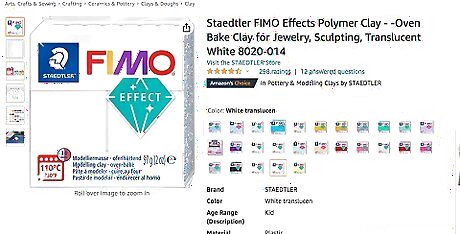
Select Fimo Eberhard Faber clay. This is the most widely-available polymer clay and the most popular among clay artists. Fimo comes in 58g (2 ounces) and 350g (12.5 ounces) packages. It is the stiffest of the clays and the most difficult to condition. Fimo's firmness lets it hold very fine detail, and smearing is rare. This is important to consider if you plan on painting your rose after crafting it. When fired, Fimo is very strong. It has a slightly glossy surface. It also buffs well and develops a high shine. This brand of clay also comes in a beautiful selection of colors, including two transparent clays, six "stone" textured clays, a glow-in-the-dark clay, and metallic colored clay ("perglantz"). There is also a soft formulation of Fimo that comes in a different selection of colors.
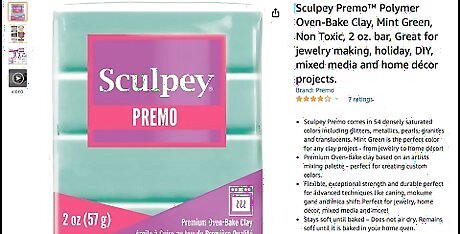
Choose Promat Polyform Products Co. clay. This is another strong type of clay - ideal for making a rose - but is slowly becoming hard to acquire because it is being phased out by Premo Sculpey clay. Promat is firmer than texture than Premo (its common substitute). It is harder to condition but less prone to smearing and stronger when fired. It is also flexible in thin sheets, which is optimal for when you craft the rose petals.

Opt for Cernit T&F GmbH clay. Cernit is the strongest of the polymer clays. Cernit has a porcelain, waxy finish when fired and is often used for doll-making because of its high quality when fired. Though Cernit is the strongest of the clays, it is not as difficult to condition as Fimo. If you have delicate hands, choose Cernit over Fimo to go easy on your hands while still ensuring sturdiness.
Crafting your Clay Rose
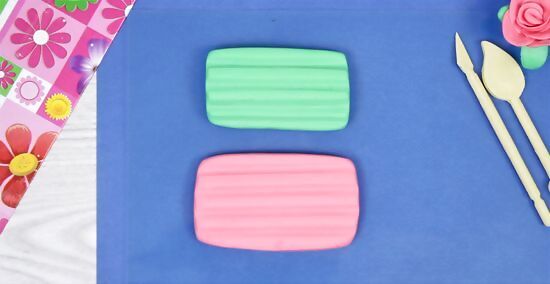
Pick a clay color to use as the rose petals. For a better finished product, choose one as close to the color red as possible. If you're going for texture, Fimo and Cernit are your best options because of their refined finish after being fired. If you're going for color, Fimo has the wider range of colors and may produce the best contrast when crafting your rose. Light pink is also a nice color. When you attach the calyx, or the green outer whorl of the flower, the contrast between colors will make your rose pop with contrast.
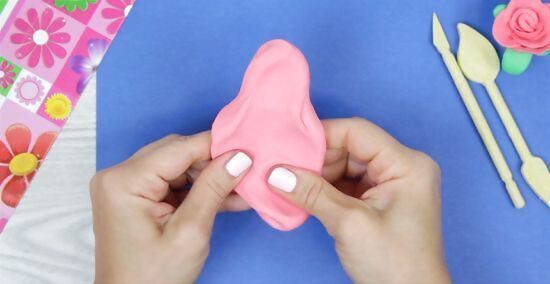
Stretch and compress the clay with your hands. This is known as conditioning, and it is necessary for making the clay ready to work with. The physical process of stretching and compressing, combined with the warmth of your hands, changes the texture of the clay, making it softer and more pliable. It also makes the clay stickier and less brittle, which is ideal when making thin sheets for the petals. Take a chunk of clay (about a half an ounce or so) and squish it between your fingers. As it warms and softens, roll it between your palms into a snake shape. Then move your hands against each other in a circular motion to compress the snake back into ball. Repeat this process several times until the clay is soft and easily molded. For stubborn clay like Fimo, there are techniques for speeding up the conditioning process. Sit on the clay for 15-20 minutes to mildly warm it. Do not lay it in the sun or on a heating pad, as excessive heat will cause the clay to start curing, making it unusable. You can also use a food processor to chop the clay into smaller pieces to condition.

Roll a ball of clay into the size you want your rose to be. Further divide this ball into seven even pieces, as these will be used to form your petals. The pieces should be about the same size, but they don't need to be exact. Having different sized petals will actually make your rose look realistic and natural. For a 2 inch (5.1 cm) wide rose, roll your clay into a 1 inch (2.5 cm) ball.
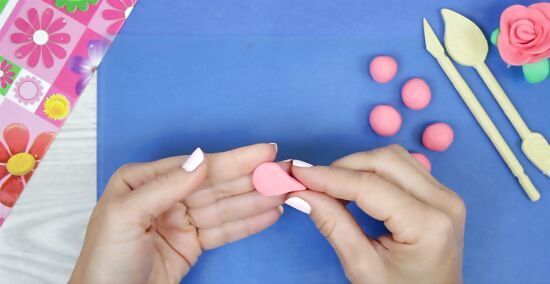
Press the smallest of the seven balls into a rounded triangular shape. This will become your first rose petal. Roll the clay ball first to make it as smooth as possible. You want few visible lines on the surface of your petal. The size and shape of this petal should be similar to a standard guitar pick. The point, which will become the base of the rose, should be thicker than the opposite edge, which will be the top of the petal. The top edge should be about 1/16 of an inch thick.

Fold the petal into a bud. Hold the petal with the thick point down and use the other hand to gently fold the sides in on themselves. The edges of the rosebud should overlap a little.

Mold the second ball of clay into a petal slightly bigger than the first. The top edge should also be slightly thinner.
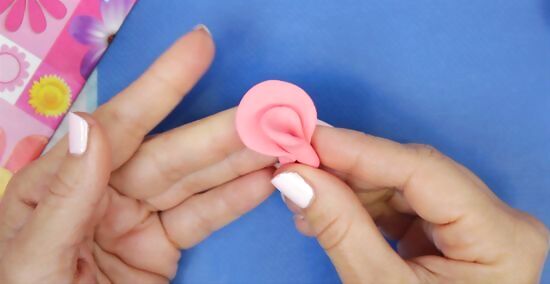
Hold the bud in one hand and wrap the second petal around it. The petal should be facing the bud, not attached to the smooth back end.
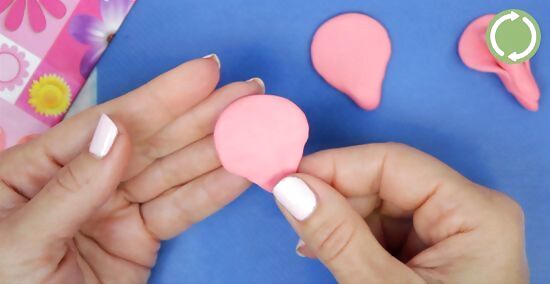
Form the third and fourth petal so that they are slightly bigger than the second. They should also be thinner than the second petal.
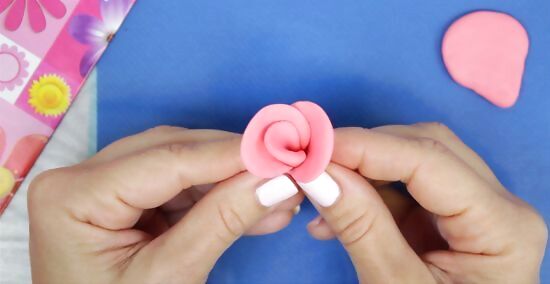
Wrap the third petal around the first two petals. This should offset it so that the three petals form a spiral when you look at the rose from above. Gently roll the edge of the third petal outward, using the tip of your finger. The edge of the petal should curl downward a bit and should stick up a little past the second petal.

Attach the fourth petal to the other three. Be sure to maintain the even, spiral design that you established in the previous step. Also roll the edge of this petal outward, making sure that it sticks up past the third petal.

Form the three outer petals. These petals can be the same size as each other but should still be larger than the third and fourth. The edges of these petals should be paper thin.

Wrap the outer petals around the flower. Be sure to evenly distribute the petals so that it retains its symmetrical shape and spiral design. Gently roll the top of the edge back after attaching each petal. For a wider, more "bloomed" flower look, curl the whole petal back. For a more bud-like look, curl just the very edge.

Squeeze the base of the rose gently once all the petals are attached. This will help meld the petals together. Hold the rose gently and use a knife or needle to cut off some of the base, making the bottom of the rose flat. This will make attaching the calyx easier.
Firing your Clay Rose
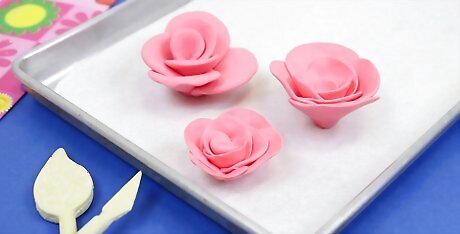
Place your rose on a baking pan and bake it in the oven for 10-15 minutes. Set the oven temperature so that it is above 210 °F (99 °C) but below 300 °F (149 °C). Heating causes chemical changes in the clay, making it hard and strong. Polymer clays, like the ones used for clay rose, don't require a special kiln and can harden normally in a standard kitchen oven. The oven temperature must reach at least 210 °F (99 °C) for the polymer to fuse properly; however, if the temperature goes above 300 °F (149 °C), the clay may burn, giving off dangerous fumes. Most manufacturers recommend temperatures between 250 and 275 degrees Fahrenheit for all clays that are not translucent. If you are using translucent clay, keep the temperature between 210 and 220 degrees Fahrenheit to avoid changing its color

Take the rose out of the oven after 10 or 15 minutes. Let it cool so that you can safely and easily attach the calyx after molding it.

Press a piece of clay into a thin sheet that is slightly larger than the rose's diameter. This will become the calyx, or the leafy outer portion, of your clay rose. The calyx should have 6-8 points and should be about 1/16th of an inch thick. Pinch the edges of each segment gently to make them thinner.
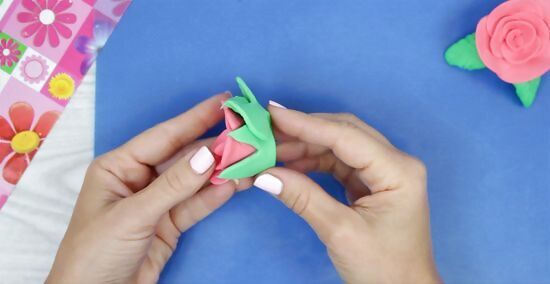
Attach the calyx to the bottom of the fired rose. Press it firmly to make sure there is good contact between the rose and calyx. Don't worry if the calyx doesn't perfectly stick to the rose. Re-firing the rose with a fresh piece of clay will create a strong bond and secure the attachment.

Bake the rose and calyx in the oven. Use the same temperature and baking time as before. Once your rose is completely done baking, let it cool for a few hours before applying paint or other decorations.
Using your Clay Rose
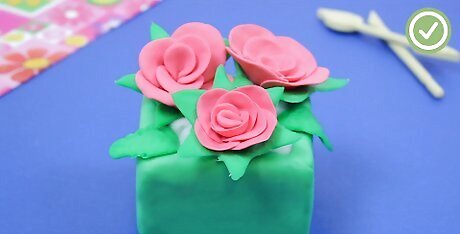
Decorate fresh clay creations with your fired rose. You can re-fire clay as many times as you'd like, offering a wide variety of decoration opportunities for your clay rose. Make a box out of strong clay and carefully attach several clay roses to the top. Attaching fired roses is ideal since joining two soft clay items can be difficult and can distort the shape. After you've successfully attached the items, fire it in the oven using the same temperature and bake time as the clay rose. Your box is now both practical and pleasant.

Make a refrigerator magnet. Use a clay rose magnet to hold up a nice family photo or flaunt a stellar report card. Simply attach a cluster of roses to a plain oval plate of clay. You can either join the two separately fired items using super glue, or you can use the fresh clay/fired clay re-fire method outlined above.

Create your own jewelry. Before you re-fire your clay rose, use a needle to make a hole in the calyx. Hang the rose on a jump ring to make a clay rose earring. Run a necklace through the calyx hole and use the rose as a pendant. Or, you can put a hair clip through the calyx hole and use it as a fancy hair clip.



















Comments
0 comment